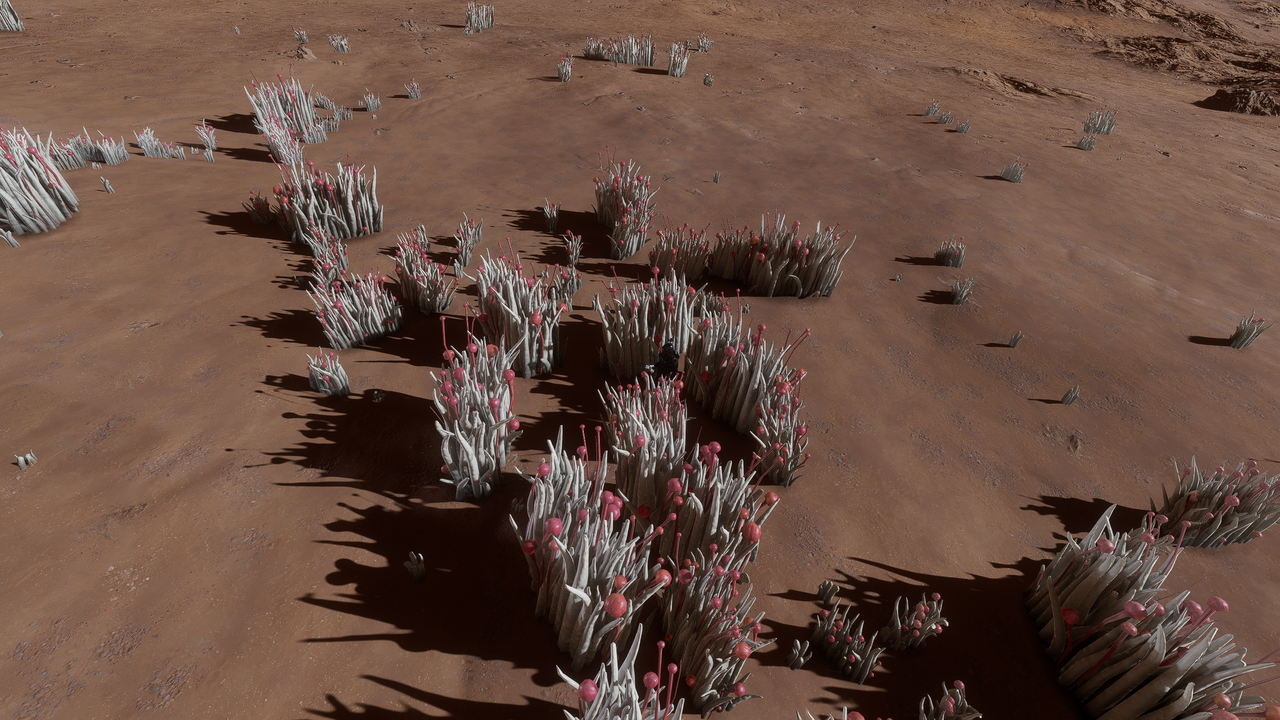JOURNEY OF A COMMANDER PART 19
04 Sep 2022Ni6h70wl
26.10.3307 Novara Expedition Day 33---Neutron star detected---
"Well, according to the map data, this system was already discovered first by Cmdr Saeon. Too bad, but you can't have everything."
The neutron star would have made a good addition to our collection of "first discovered systems".
Nevertheless, I decided to pay a visit to the moon of a gas giant, Hypoi Flyuae DC-B d1-100. Apparently, the Cmdr did not yet have the necessary landing suite to land on the planet, because the surface appeared untouched and there was no information about the biological signals displayed in the VSS.
Before we set course for the celestial body, I loaded the FSD in the jet of the neutron star, against all safety regulations. You can't miss a 200ly jump.
Once again it was a moon with an ammonia atmosphere, this type of atmosphere is relatively common.

The following biodata were successfully collected:
- Cactoida Peperatis
- Frutexa Flammasis
- Bacterium Alcyoneum
- Fungoida Setisis
- Tussock Catena

The subtype Peperatis is a species of cactus that appears as a swollen, five-sided plant that grows over two metres tall and ends with a crossed crown. Here, too, it is suspected that the colouring depends on the star class.

The other life forms are a woody plant, a bacterium, a fungus and a grass species. Basically, a quite animate celestial body for its size. More complex life forms have not been encountered, probably due to the low atmospheric density.
Before leaving the system we were able to see several bio-signs on an icy moon, with a surface temperature of 100K I didn't expect so much life. The exploration of the icy moon was postponed until tomorrow, we had enough time.
Neutron stars

Neutron stars are the stellar remnants of massive stars (over 8 solar masses) that have reached the end of their lives. After nuclear fusion was exhausted, the star collapsed to a tiny volume.
Neutron stars are spherical bodies with typical radii of about 10 to 16 km, very small by stellar standards. The masses of the neutron stars discovered so far are between about 1.2 and 2.5 solar masses, making them extremely compact. Their density increases from about 1 x 109 kg/m3 at their crust with depth to about 6 x 1017 to 8 x 1017 kg/m³, which is about three times the density of an atomic nucleus. The average density of a neutron star is about 3.7 to 5.9 x 1017 kg/m³. This makes neutron stars the densest known objects without an event horizon. Typical stars of this type rotate very fast and have a strong magnetic field.
In the 34th century, the current mass limit of neutron stars was raised to 16 solar masses. Nevertheless, it is unclear why stars with more than 2.5 solar masses do not always collapse into a stellar black hole but remain a neutron star.
Due to its high mass, matter has collapsed into degenerate neutron matter (sometimes called neutronium), an extremely dense state consisting solely of neutrons (matter consisting of substances other than atoms, e.g. quarks, protons, neutrons or others, is called "degenerate matter"). Unlike most degenerate matter, where the electrons are below the Fermi energy (chemical potential at T=0), the compression is so strong that the Fermi energy of the electrons increases, so they combine with protons to form neutrons. Since the star is in equilibrium, its gravity is balanced by the "neutron degeneracy pressure" (compressed neutron wave functions that are energetic due to the uncertainty principle), although if the system were more massive, its gravity would overcome the neutron degeneracy pressure and form a black hole. Stars with degenerate matter are as dense as matter can be without becoming a black hole.
Even experienced commanders have to be careful when approaching these stellar corpses, because they are so small that they are almost invisible. They still radiate heat, and if you approach them closer than 0.25 Ls, the heat generation increases rapidly. Flying your ship into the energy cone recharges the FSD above normal capacity and dramatically increases the jump range for the next jump. However, leaving the Supercruise in the beam of a neutron star is life-threatening, as the incredibly fast particles of ionised matter will tear your ship's hull and systems apart.
27.10.3307 - Novara Expedition Day 34
The moons Hypoi Flyuae DC-B d1-100 3 c - 3 e all harboured the same species living in a neon atmosphere:
- Electricae Pluma
- Fonticulua Campestris
- Bacterium Vesicula


The most fascinating is the type Electricae, after I had taken the necessary samples, it turned out that these organisms are found exclusively on these extremely cold ice worlds near frozen lakes. The visible tips protrude from the ice, often near cracks where it is thinnest. Most of the organisms extend through the ice into the underground melt zone, which can be several kilometres long. Electricae are superconducting by nature and use the thermal circulation of the surrounding fluid to drive an electrochemical process. This is probably why they are only found on planets with noble gas atmospheres. The surface structure establishes a connection to the atmosphere, which in turn creates a point of electrical potential difference. A by-product of this is the bioluminescence that permeates the organism. Although never observed, reproduction probably occurs below the surface by an unknown process.
The Puma subtype is a type of Electricae that extends a spire of four interconnected loops above the ice, each covered with brightly glowing fronds. This type is apparently only found on planets orbiting bright white stars.
Apparently, the neutron star belongs to this category; in terms of habitable zones, the neutron star ranks between A and B stars.
After collecting the samples on the other icy moons, we left the system with a 200ly jump.

29.10.3307 - Novara Expedition Day 36
We have been underway for over 5 weeks, two years' worth of supplies have been stowed on board. Quite a lot when you consider that 420 people have to be fed. Almost 250 tonnes of food, excluding drinks, are on board the Novara and are used to supply the crew. This is already the capacity limit, the ship cannot be underway longer without replenishing the supplies. Water is collected in the area of ice rings as needed and is permanently available.
We were also able to collect several plant samples in one system for our exobiology laboratory on deck 11.

Decks 11 - 12 of the Novara
The top decks of the Novara are reserved for scientific investigations and house a large amount of high-tech equipment for research.
Deck 11 is completely windowless and the interior is again specially lined to achieve a radiation level of 0.1 µSv/h. The normal ship's area is enclosed in a bundle of glass.
The normal ship's area is exposed to an hourly radiation level of 0.4 µSv and 4 µSv in the area of the glazing.
These values are harmless for life on board, even over a longer period of time.
On a length of 74m and a width of 40m there are various research facilities:
- Exobiology laboratory - In this laboratory, the collected exobiological samples are examined and researched.
- Xenology laboratory - Here findings of possible intelligent species are examined, so far only samples of the Thargoids and Guardians could be examined. My scientists show great interest in the Soontil relics and the Mars relic, which has been kept under lock and key so far.
- Geology and Mineralogy Laboratory - Parts of the collected raw materials from alien planetary surfaces are examined here and compared with the rock composition of Earth. The composition data of rings and asteroid clusters are also evaluated here.
- Medical laboratory - This is used to carry out the necessary examinations in the event of the occurrence of pathogens of an extraterrestrial nature and, if necessary, to develop suitable medicines.
- Greenhouse with hydroponics - Here we try to find out under which conditions a plant grows and to what extent it can be genetically modified to tolerate other climatic conditions.
Deck 12 is still divided into sub-areas of astronomy, but here the boundaries become blurred.
